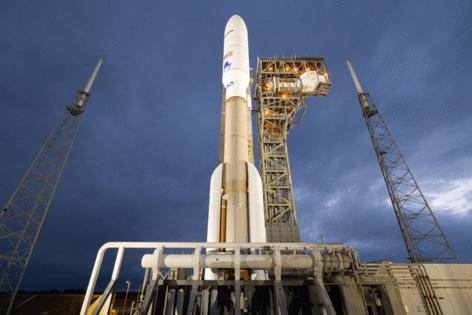United Launch Alliance back to try 1st launch of year with Amazon satellites
Published in News & Features
It’s been nearly seven months since United Launch Alliance had its last rocket launch, but the company’s first flight of 2025 could come to fruition on Monday night.
A ULA Atlas V on the Kuiper 1 mission carrying 27 of Amazon’s satellites for its Project Kuiper broadband internet constellation is targeting liftoff at 7 p.m. Eastern time at the opening of a two-hour launch window from Cape Canaveral Space Force Station’s Space Launch Complex 41 in Florida.
Space Launch Delta 45’s weather squadron forecasts a 75% chance for good launch conditions, which increases to 90% if the attempt is delayed to Tuesday night.
The launch attempt comes more than two weeks since a first tryt that was stymied by weather forcing a scrub.
The launch would be the first since ULA’s Cert-2 mission of its new Vulcan rocket that flew on Oct. 4, 2024. ULA had been hoping to get a quick certification of the Vulcan from the Space Force that would open up the door for the company to begin using it to start knocking out a backlog of national security missions. The certification process, though, stretched for months, only coming on March 26.
The delays forced ULA to pivot and line up the commercial mission for Amazon on one of its few remaining Atlas V rockets.
Since ULA last launched, the Space Coast has seen SpaceX launch 59 times and Blue Origin once. ULA had only five launches in 2024 and three in 2023. CEO Tory Bruno in March had said he hoped ULA would fly 12 missions in 2025.
Amazon had bought up nine of the final Atlas V rockets, and used one to send up a pair of test satellites from Project Kuiper in October 2023. It took more than a year and half for Amazon to nail down the design and get enough satellites ready for it to start sending them to space, though.
After Kuiper 1, ULA has only 14 more of the workhorse rockets left including seven more set aside for for Amazon, one for a communications satellite for commercial company ViaSat that could launch this year and six set aside for future Boeing Starliner launches.
Its retirement along with the already-retired Delta IV class of rockets comes as Vulcan looks to take over. ULA already has 70 launches lined up for the new rocket including 38 more for Amazon.
Those Vulcan launches for Amazon, though, won’t likely begin until all of its Atlas V missions are flown.
Amazon is looking to compete with SpaceX’s Starlink satellite service, and has a license from the Federal Communications Commission to operate 3,232 satellites. The FCC requirement, though, calls for half to be in place by July 2026, and all in place by 2028.
So in addition to ULA, Amazon has lined up dozens more flights with Blue Origin, Arianespace and even some with SpaceX.
SpaceX already has around 6,500 of its Starlink satellites in an operational orbit serving more than 5 million customers worldwide.
Amazon’s satellites are constructed in Washington, but the final processing done in Florida. Amazon has a new facility at an 80-acre site at Kennedy Space Center’s former Shuttle Landing Facility that is slated to begin take over that final process, with the company aiming to get the supply chain of satellites sped up to try and meet the FCC deadlines.
ULA meanwhile continues to build out a second rocket integration building at SLC-41 so that it can juggle the commercial launches needed for the likes of Amazon and other customers while catching up on its backlog of missions for the Department of Defense.
Amazon expects to begin satellite internet service to customers before year’s end.
------------
©2025 Orlando Sentinel. Visit at orlandosentinel.com. Distributed by Tribune Content Agency, LLC.







Comments